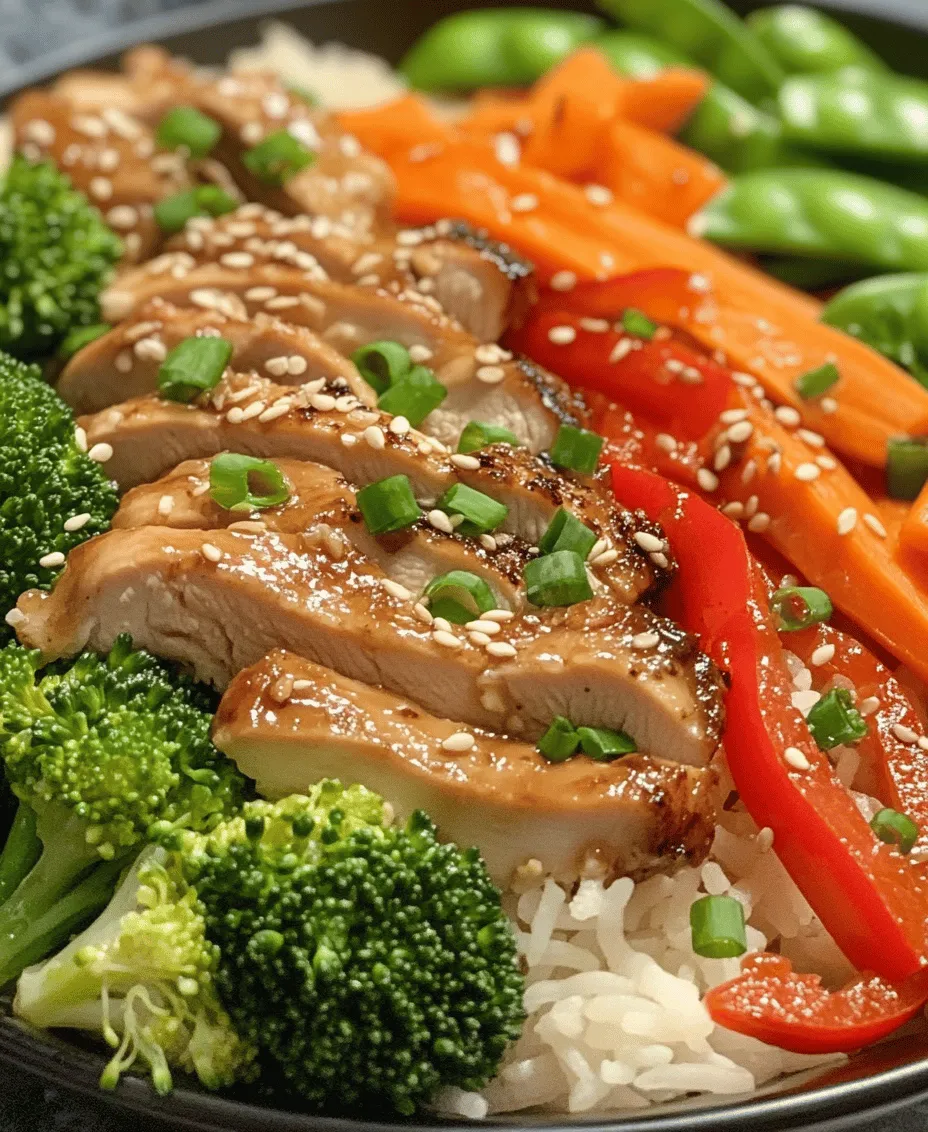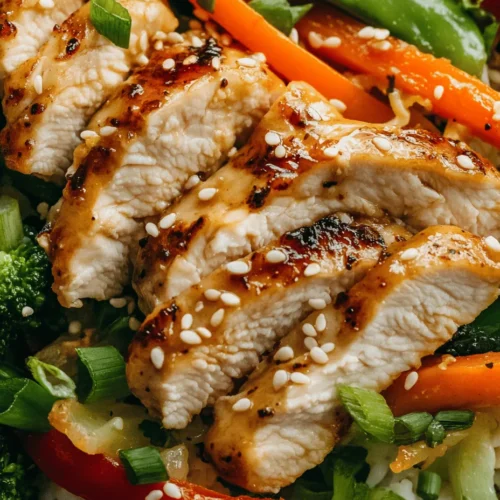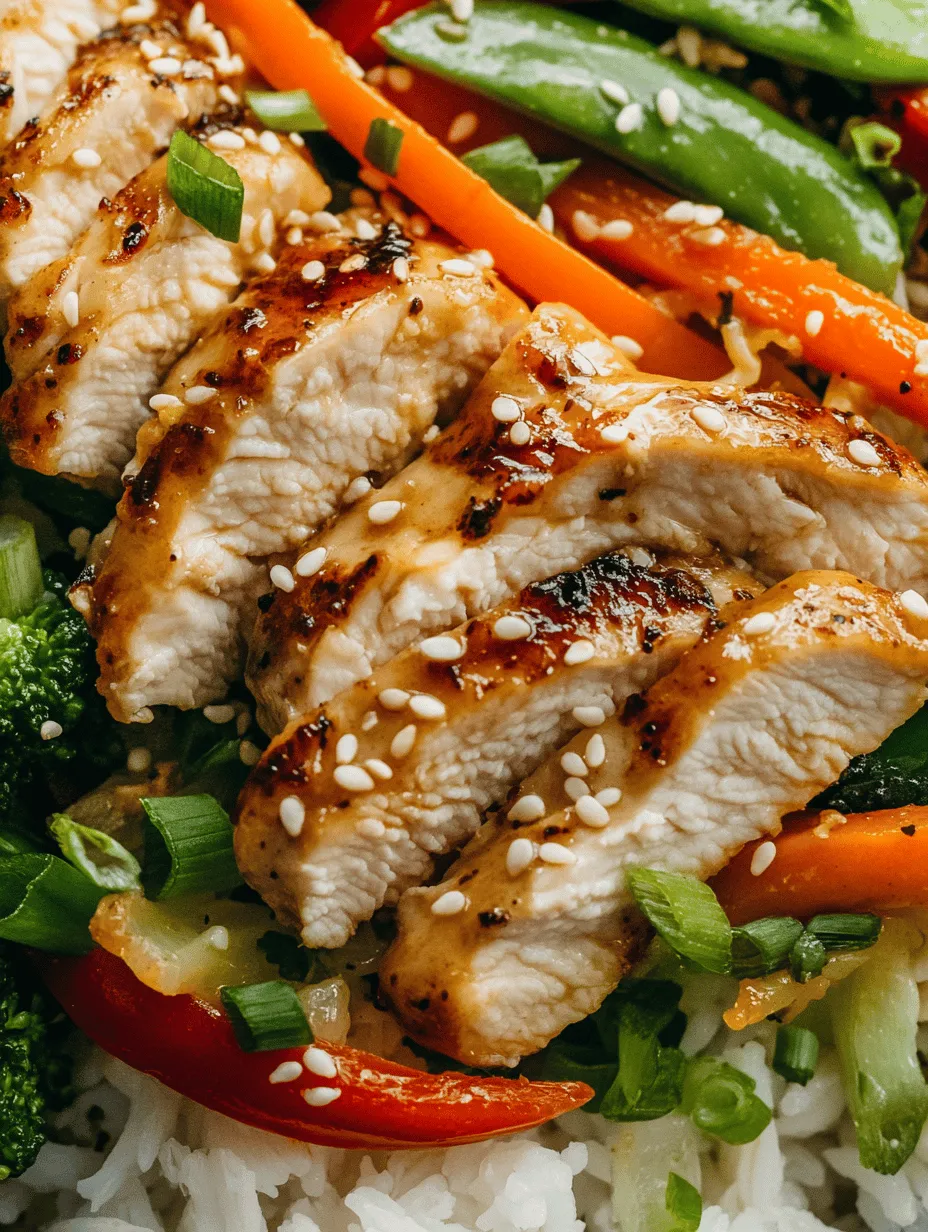Introduction
Stir fry dishes have long captivated culinary enthusiasts with their vibrant colors, tantalizing flavors, and quick cooking methods. Among the many variations, sesame ginger chicken stir fry stands out as a perfect blend of savory and slightly sweet notes, complemented by the nutty aroma of sesame oil. This dish not only showcases an explosion of flavors but also embodies the essence of quick and healthy meals that fit seamlessly into today’s fast-paced lifestyle. Whether you’re a busy professional, a parent juggling multiple responsibilities, or simply someone who enjoys a delicious home-cooked meal, sesame ginger chicken stir fry is sure to become a staple in your kitchen.
In this article, we will guide you through everything you need to know to create this flavorful dish. From the essential ingredients and their nutritional benefits to step-by-step cooking instructions, we’ve got you covered. Additionally, we will share insights into the health benefits associated with each component, ensuring that you not only enjoy a delicious meal but also nourish your body. Let’s dive into the world of sesame ginger chicken stir fry!
Understanding the Key Ingredients
To create a standout sesame ginger chicken stir fry, it’s crucial to understand the role and benefits of each ingredient. This section will provide an overview of the key components that make this dish not only flavorful but also nutritious.
Chicken: Nutritional Benefits and the Ideal Cut
The star of our stir fry is chicken, specifically boneless, skinless chicken breasts. This choice is ideal for several reasons. First, boneless, skinless chicken breasts are a lean source of protein, making them a great option for those looking to maintain a healthy diet. Each serving is packed with essential amino acids that support muscle repair and growth, making it a favorite among fitness enthusiasts.
In addition to being low in fat, chicken breasts are rich in vitamins and minerals such as niacin, which aids in energy production and supports cardiovascular health, and selenium, a powerful antioxidant that helps protect the body from oxidative stress. The mild flavor of chicken also allows it to absorb the rich flavors of the marinade and sauce, making it the perfect canvas for this stir fry.
Sesame Oil: Flavor and Health Benefits
Next up is sesame oil, an ingredient that not only enhances the flavor of our stir fry but also brings a wealth of health benefits. This oil is derived from sesame seeds and has a distinct nutty flavor that elevates any dish. Rich in healthy fats, particularly polyunsaturated fatty acids, sesame oil can help lower bad cholesterol levels and improve heart health when used in moderation.
Moreover, sesame oil contains antioxidants and anti-inflammatory properties that can benefit skin health and reduce the risk of chronic diseases. The aroma and taste of sesame oil are integral to our stir fry, as it adds depth and richness to the overall flavor profile.
Fresh Ginger and Garlic: Their Roles in Flavor and Health
No stir fry is complete without the aromatic duo of fresh ginger and garlic. Both ingredients are known for their unique flavors and numerous health benefits. Fresh ginger adds a warm, slightly spicy taste that pairs beautifully with the other components of the dish. It is also celebrated for its anti-inflammatory properties and can aid in digestion, making it a fantastic addition to any meal.
Garlic, on the other hand, contributes a robust flavor and is renowned for its immune-boosting properties. Packed with vitamins C and B6, manganese, and selenium, garlic is a powerful ally in supporting overall health. Together, ginger and garlic create a flavorful base that enhances the taste of the chicken and vegetables, making every bite a delightful experience.
Vegetables: Nutritional Value of Broccoli, Bell Peppers, Snap Peas, and Carrots
A stir fry wouldn’t be complete without a vibrant assortment of vegetables. For our sesame ginger chicken stir fry, we’ll be using broccoli, bell peppers, snap peas, and carrots. Each of these vegetables not only adds a pop of color but also contributes essential nutrients.
– Broccoli is a powerhouse of vitamins K and C, fiber, and antioxidants. It promotes healthy digestion and supports the immune system.
– Bell peppers, especially the colorful varieties, are rich in vitamins A and C, potassium, and folic acid. Their sweet flavor complements the savory chicken and sauce perfectly.
– Snap peas are not only crunchy and sweet but also provide a good source of vitamin C, fiber, and several antioxidants. They retain their crispness in the stir fry, adding a delightful texture.
– Carrots are high in beta-carotene, which converts to vitamin A in the body, supporting eye health and immune function. Their natural sweetness balances the savory elements of the dish.
Including these vegetables not only enhances the nutritional profile of the sesame ginger chicken stir fry but also adds layers of texture and taste that make each bite satisfying.
Sauce Components: Importance of Low-Sodium Soy Sauce and Natural Sweeteners
The sauce is the heart of any stir fry, and for our sesame ginger chicken stir fry, we’ll be using low-sodium soy sauce as a base. Traditional soy sauce can be high in sodium, which may not be ideal for everyone. Opting for low-sodium soy sauce allows you to enjoy the umami flavor without compromising health.
In addition to soy sauce, we’ll incorporate natural sweeteners such as honey or maple syrup. These sweeteners not only enhance the overall flavor but also provide a healthier alternative to refined sugars. Balancing the salty, sweet, and savory elements in the sauce is crucial for achieving the perfect stir fry experience.
Preparing for the Stir Fry
Preparation is key to a successful stir fry. The cooking process is quick, so having everything prepped and ready to go will ensure that your meal comes together seamlessly. In this section, we will cover essential meal prep tips, including slicing and marinating the chicken, preparing the vegetables, and understanding the role of marinating.
Importance of Meal Prep: Tips on Slicing and Marinating Chicken
When it comes to stir frying, thinly sliced chicken cooks faster and absorbs flavors more effectively. To achieve this, start by partially freezing the chicken breasts for about 30 minutes. This will make it easier to slice them into uniform pieces. Aim for slices that are about 1/4 inch thick for optimal results.
Marinating the chicken is another critical step. A simple marinade made from soy sauce, sesame oil, grated ginger, and minced garlic will infuse the chicken with flavor and help tenderize the meat. Allow the chicken to marinate for at least 30 minutes to 1 hour in the refrigerator. For even better results, consider marinating it overnight.
Strategies for Prepping Vegetables: How to Ensure They Remain Crisp and Bright
Vegetable preparation is equally important in achieving the desired texture and flavor in your stir fry. Start by washing and cutting the vegetables into bite-sized pieces. To keep your vegetables crisp and bright, consider blanching them briefly in boiling water before adding them to the stir fry. This technique enhances color retention and minimizes cooking time.
For the broccoli, cut the florets into smaller pieces, while the bell peppers can be sliced into strips. Snap peas can be left whole or cut in half, and carrots should be sliced thinly to ensure even cooking. Having all your vegetables prepped and ready to go will allow for a quick and efficient cooking process.
The Role of Marinating: Enhancing Flavor and Tenderizing Chicken
Marinating is an essential technique for infusing flavors into your stir fry. As the chicken soaks in the marinade, it not only absorbs the savory elements but also breaks down proteins, resulting in a tender and juicy texture. The combination of soy sauce, sesame oil, ginger, and garlic creates a flavor profile that permeates the chicken, making each bite delicious.
While marinating, it’s essential to choose the right container. A resealable plastic bag or a shallow dish works well, as both allow for even distribution of the marinade. Be sure to turn the chicken occasionally to ensure that all pieces are coated with the flavorful mixture.
Step-by-Step Cooking Instructions
Now that we have all our ingredients prepped and our chicken marinated, it’s time to dive into the cooking process. Stir frying is all about speed and high heat, so having everything organized will make this part of the recipe a breeze.
Marinating the Chicken: Techniques and Timing
As previously mentioned, marinating the chicken is vital for flavor and tenderness. After slicing the chicken and preparing the marinade, place the chicken in the marinade and refrigerate it for at least 30 minutes to 1 hour. If you have the time, marinating overnight will yield even better results.
When you’re ready to cook, remove the chicken from the marinade and allow any excess liquid to drip off. This will prevent the stir fry from becoming watery and will help achieve a nice sear on the chicken.
Preparing the Sauce: Balancing Flavors for the Perfect Stir Fry
Before cooking, it’s a good idea to prepare the stir fry sauce. In a small bowl, combine low-sodium soy sauce, a touch of honey or maple syrup, and a splash of sesame oil. If desired, add a pinch of red pepper flakes for a hint of heat. Mix everything well and set it aside for later use. This sauce will bring all the ingredients together, creating a harmonious flavor profile.
Heating the Pan: Importance of Temperature in Achieving the Right Texture
When it comes to stir frying, heat is your best friend. Preheat a large wok or non-stick skillet over medium-high heat. Once the pan is hot, add a drizzle of sesame oil to coat the bottom. It’s important to ensure that the oil is shimmering before adding the chicken. This high heat will allow the chicken to sear quickly, locking in juices and creating a delicious, slightly crispy exterior.
As the chicken cooks, avoid overcrowding the pan. If necessary, cook the chicken in batches to ensure even cooking. Stir frequently to prevent sticking and ensure that each piece is cooked through. Once the chicken is golden brown and cooked to perfection, remove it from the pan and set it aside.
With the chicken cooked, the next steps will involve quickly stir frying the vegetables and combining everything with the sauce for a delicious finish. Stay tuned for the next part of our article, where we will guide you through completing this delectable sesame ginger chicken stir fry!

Sautéing the Vegetables: Techniques for Maintaining Color and Crunch
To achieve a perfect Sesame Ginger Chicken Stir Fry, it’s essential to sauté the vegetables correctly. Start by heating your wok or large skillet over medium-high heat until it’s hot. A well-heated surface allows for quick cooking, which helps retain the vegetables’ vibrant colors and crunchy textures.
Technique Tips:
– Blanch and Shock: For vegetables like broccoli or snap peas, consider blanching them in boiling water for a minute, then quickly transferring them to ice water. This method preserves their bright color and crispness.
– Cut Uniformly: Chop your vegetables into uniform sizes to ensure they cook evenly. For instance, slice bell peppers into thin strips and chop carrots into matchsticks.
– Stir Constantly: Use a spatula to keep the vegetables moving around the pan. This constant agitation prevents burning and allows for even cooking.
– Add in Stages: Start with the vegetables that take longer to cook, such as carrots or broccoli, and add quicker-cooking ones like bell peppers and snap peas later. This technique maximizes crunch and freshness.
By following these tips, your vegetables will not only look appealing but also provide a satisfying texture that complements the tender chicken.
Combining Ingredients: Ensuring Even Coating of Sauce
Now that your chicken and vegetables are perfectly cooked, it’s time to combine them with the sauce. The key to a fantastic stir fry is ensuring every ingredient is well-coated with the flavorful sesame ginger sauce.
1. Add the Sauce Gradually: Pour the sauce over the chicken and vegetables while they are still in the pan. This method allows the heat to activate the flavors and encourages the sauce to cling to the ingredients.
2. Toss Gently: Use your spatula to gently toss the chicken and vegetables in the sauce. Aim for a folding motion rather than vigorous stirring to avoid breaking the vegetables.
3. Cook Briefly: Allow the mixture to cook for another minute or two. This step helps the sauce thicken slightly and ensures that all ingredients are heated through without overcooking.
By achieving an even coating of sauce, you ensure that each bite is packed with robust flavors, making your Sesame Ginger Chicken Stir Fry a harmonious blend of taste and texture.
Thickening the Sauce: The Science Behind Cornstarch as a Thickening Agent
A key component of a well-executed stir fry is the sauce’s consistency. Cornstarch is an excellent thickening agent that helps create a silky, clingy sauce that enhances the dish without overpowering it.
How it Works:
– Hydration: When cornstarch is mixed with a liquid, it absorbs water and swells. This process creates a gel-like consistency, which helps to thicken sauces without altering their flavor.
– Application: To use cornstarch effectively, prepare a slurry by mixing equal parts cornstarch and cold water in a small bowl. Once your chicken and vegetables are combined with the sauce, slowly drizzle the cornstarch slurry into the pan while stirring. The heat will activate the thickening property of the cornstarch, resulting in a beautifully glossy sauce that clings to the ingredients.
The result is a harmonious blend of flavors and textures, ensuring that your Sesame Ginger Chicken Stir Fry is not only delicious but also visually appetizing.
Serving Suggestions: Creative Ideas for Presenting the Dish
Presentation is key when it comes to enjoying your Sesame Ginger Chicken Stir Fry. Here are some creative ideas for serving:
1. Over a Bed of Rice or Noodles: Serve the stir fry over steamed jasmine rice or soba noodles for a complete meal. The grains will absorb the sauce, adding another layer of flavor.
2. Garnish with Fresh Herbs: Sprinkle chopped green onions or cilantro over the dish just before serving for a fresh touch. The herbs not only enhance the flavor but also add a pop of color.
3. In Lettuce Wraps: For a low-carb option, serve the stir fry in crisp lettuce leaves. This method creates a fun and interactive dining experience, allowing guests to assemble their wraps.
4. With Sesame Seeds: Toasted sesame seeds can be sprinkled on top to provide a nutty flavor and additional crunch.
By considering these serving suggestions, you can elevate your Sesame Ginger Chicken Stir Fry into a visually appealing and satisfying dish.
Nutritional Breakdown
Understanding the nutritional content of your Sesame Ginger Chicken Stir Fry is essential for maintaining a balanced diet. Here’s a breakdown of the nutritional components per serving:
– Calories: Approximately 350-400 calories
– Protein: 30 grams (from chicken)
– Carbohydrates: 30 grams (mostly from vegetables and sauce)
– Fats: 15 grams (healthy fats from sesame oil)
– Fiber: 4-5 grams (from vegetables)
Health Benefits:
Including lean protein and a variety of vegetables in your meals offers numerous health benefits. Lean proteins, such as chicken, support muscle growth and repair, while vegetables provide essential vitamins, minerals, and antioxidants that boost overall health.
Homemade vs. Takeout:
When comparing homemade stir fry to takeout options, the homemade version typically offers more control over ingredients, resulting in a healthier meal. Takeout often contains higher levels of sodium and unhealthy fats, while homemade dishes can be tailored to fit dietary preferences and nutritional needs.
Variations and Adjustments
To accommodate dietary restrictions and personal preferences, here are several variations and adjustments you can make to the Sesame Ginger Chicken Stir Fry:
1. Gluten-Free Options: If you require a gluten-free dish, substitute soy sauce with tamari or coconut aminos. These alternatives provide a similar flavor without the gluten.
2. Vegetarian/Vegan Adaptations: For a vegetarian or vegan version, replace the chicken with tofu or tempeh. Both options absorb flavors well and provide a good source of protein. Before adding to the stir fry, marinate the tofu in soy sauce and ginger for enhanced flavor.
3. Seasonal Vegetables: Feel free to incorporate seasonal vegetables like zucchini, asparagus, or bok choy. This not only adds variety but also ensures you’re utilizing fresh produce.
4. Flavor Enhancements: Experiment with different spices or sauces. Adding a dash of chili paste for heat or a splash of rice vinegar for acidity can elevate the flavor profile of your stir fry.
By adapting the recipe to fit various dietary needs and preferences, you can enjoy a delicious and nutritious meal that caters to everyone at the table.
Cultural Significance of Stir Fry
Stir frying is a traditional cooking method with deep roots in Asian cuisine, particularly in China. It is believed to have originated during the Han dynasty (206 BC – 220 AD) when rapid cooking over high heat became popular. The stir fry technique allows for quick cooking, preserving the nutrients and flavors of the ingredients.
The versatility of stir fry extends beyond Asian cuisine, as many cultures have adopted similar cooking methods. For instance, the Italian “saltimbocca” features meat sautéed with herbs, while the Mediterranean region boasts various vegetable sauté dishes.
Incorporating stir fry into a balanced diet is a practical approach to meal planning. By combining protein, vegetables, and healthy fats, stir fry can serve as a wholesome and satisfying meal option.
Conclusion
Making Sesame Ginger Chicken Stir Fry is not only easy but also a delightful way to explore a variety of flavors and textures. This recipe emphasizes the importance of fresh ingredients and allows for endless modifications to cater to personal tastes and dietary needs.
As you experiment with different vegetables and cooking methods, remember that the beauty of stir fry lies in its versatility. Whether you stick to the traditional recipe or venture into creative variations, your stir fry will always be a delicious and nutritious choice. Embrace the joy of cooking and the vibrant flavors that can be achieved with simple, fresh ingredients.



